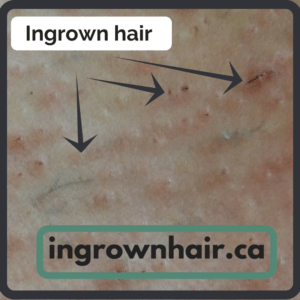What is the medical term for razor burn?
The medical term for razor burn is more complicated than most people think. It depends on how severe and what it presents as.
It can be either pseudofolliculitis or folliculitis barbae.
The difference is:
Pseudofolliculitis barbae presents as ingrown hairs associated with flesh-coloured or red follicular papules, which may be itchy or tender. Pseudofolliculitis barbae is a clinical diagnosis. Magnification, eg dermatoscopy, may be necessary to see the ingrown hairs.
Folliculitis barbae presents as painful pustules and can discharge pus. Both can look like acne or rash on the area that you have just shaved. It is also refered to as razor burn or ingrown hairs
Both can cause scarring and infection –www.dermnetnz.org
You should see a doctor for a diagnosis before pursuing home treatment.
Razor burn is a red rash that happens after you shave.
Not everyone gets razor burn, but it is a common occurrence on many people who shave.
What does razor burn look like:
Razor burn is red and can be painful. The skin is usually inflamed and can often feel like your skin is burning. It can also feel itchy and have bumps.




How do you prevent razor burn:
Razor burn is relatively easy to prevent. If you change just a few of your daily habits, you can easily prevent it. Here are a few tips to prevent razor burn:
- Purchase a quality shaving lubricant (cream, foam or gel) This will allow your razor to glide over your skin without creating any friction. You may have to try a couple of brands before you find the one that is the best for your skin.
- Use a good quality razor. Purchase on that is well known and comes with multiple blades. Good razors can be expensive but there are many subscription services to help bring down the cost. You can even purchase them on Amazon for a really good price.
- Use a new clean blade. It is important that you use a clean sharp blade. This means replacing your blade more often. After shaving make sure you thoroughly rinse the blade and shake it to dry it. Store your blade in a dry area.
- When you are shaving, try not to pull the skin tight. If you use a good quality lubricant, you should not need to do this! Shave with direction of the hair growth in light short strokes.
One thing you should also do to prevent razor burn in to treat your skin kindly. Consider using a home facial regime. When your skin is healthy and moisturized, you are less likely to get a razor burn.
How do you treat razor burn:
If you have razor burn already, then you are probably in need of some relief. There are some products that are made specifically for razor burn.
These products contain beneficial ingredients like jojoba oil, coconut oil, Acetylsalicylic Acid, witch hazel as well as other ingredients to make the products stable and have a long shelf life.
Commercial we recommend:
Natural remedies to treat razor burn:
If you would prefer to go the au natural route you can try traditional ingredients that are found at home or at the grocery store.
•A cool cloth pressed on your face
•Aloe vera gel –Apply a small amount to the affected area after cleansing face.
•Coconut oil-After washing your face moisturize your skin with coconut oil.
•Witch hazel-Dab a small amount on the area 2 times per day
•Chamomile Brew chamomile tea. Once cool, place the tea bags on the affected area or a cotton swab soaked in the tea.
You can try these individually or together. Try to stay away from any oils that might sting ( tea tree, lavender) unless you dilute them a lot with a carrier oil.
Razor burn is easy to treat and prevent. You might have to try a few products or remedies before you find relief.
If you liked this article you might want to read The best hair removal options. It will explain to you a few different options for hair removal that might work for you.

